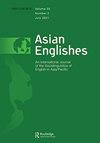扩展圈东亚地区的语境教学——台湾与日本初中英语教材的比较分析
IF 1.8
Q1 LINGUISTICS
引用次数: 1
摘要
摘要:本比较研究探讨了英语作为一种国际语言(EIL)是如何在两个扩展圈-东亚(ECEA)教育背景下(台湾和日本)形成的。它采用EIL和“官方知识”的范式透镜作为概念工具来解释英语教科书中所代表的知识,文化和信仰。采用定性内容分析的方法,对台湾和日本四套初中英语教材进行了研究。研究结果从以下方面进行了讨论:首先,国际和跨文化内容的不同EIL规划心态;其次,在课程政策背景下(非)制度化的EIL;第三,学校英语教材中的民族认同主张。讨论有助于理解在ECEA地区的学校中教授EIL是如何受到国家课程传统的制约的。本研究除了拓展东亚学校教育中EIL研究的理论层面外,也为EIL课程的发展提供了地方敏感的建议。本文章由计算机程序翻译,如有差异,请以英文原文为准。
Contextualising teaching EIL in the Expanding Circle-East Asian region: a comparative analysis of junior secondary English textbooks in Taiwan and Japan
ABSTRACT This comparative study examines how English as an international language (EIL) is framed in two Expanding Circle-East Asian (ECEA) educational contexts (Taiwan and Japan). It employs the paradigmatic lens of EIL and ‘official knowledge’ as conceptual tools to interpret knowledge, culture, and belief represented in English textbooks. Four series of junior secondary English textbooks in Taiwan and Japan were examined through qualitative content analysis. Findings were discussed in terms of, firstly, different EIL planning mentalities of the international and intercultural contents; secondly, (un)institutionalised EIL within the curriculum policy contexts; thirdly, the assertion of national identities in school English textbooks. The discussion contributed to understanding how teaching EIL in schools in the ECEA region was conditioned by the national curriculum traditions. In addition to expanding the theoretical aspects of EIL studies in school education in East Asia, the study provides suggestions for developing the EIL curriculum in a local-sensitive way.
求助全文
通过发布文献求助,成功后即可免费获取论文全文。
去求助
来源期刊

Asian Englishes
LINGUISTICS-
CiteScore
3.30
自引率
18.80%
发文量
34
期刊介绍:
Asian Englishes seeks to publish the best papers dealing with various issues involved in the diffusion of English and its diversification in Asia and the Pacific. It aims to promote better understanding of the nature of English and the role which it plays in the linguistic repertoire of those who live and work in Asia, both intra- and internationally, and in spoken and written form. The journal particularly highlights such themes as: 1.Varieties of English in Asia – Including their divergence & convergence (phonetics, phonology, prosody, vocabulary, syntax, semantics, pragmatics, discourse, rhetoric) 2.ELT and English proficiency testing vis-a-vis English variation and international use of English 3.English as a language of international and intercultural communication in Asia 4.English-language journalism, literature, and other media 5.Social roles and functions of English in Asian countries 6.Multicultural English and mutual intelligibility 7.Language policy and language planning 8.Impact of English on other Asian languages 9.English-knowing bi- and multilingualism 10.English-medium education 11.Relevance of new paradigms, such as English as a Lingua Franca, to Asian contexts. 12.The depth of penetration, use in various domains, and future direction of English in (the development of) Asian Societies.
 求助内容:
求助内容: 应助结果提醒方式:
应助结果提醒方式:


